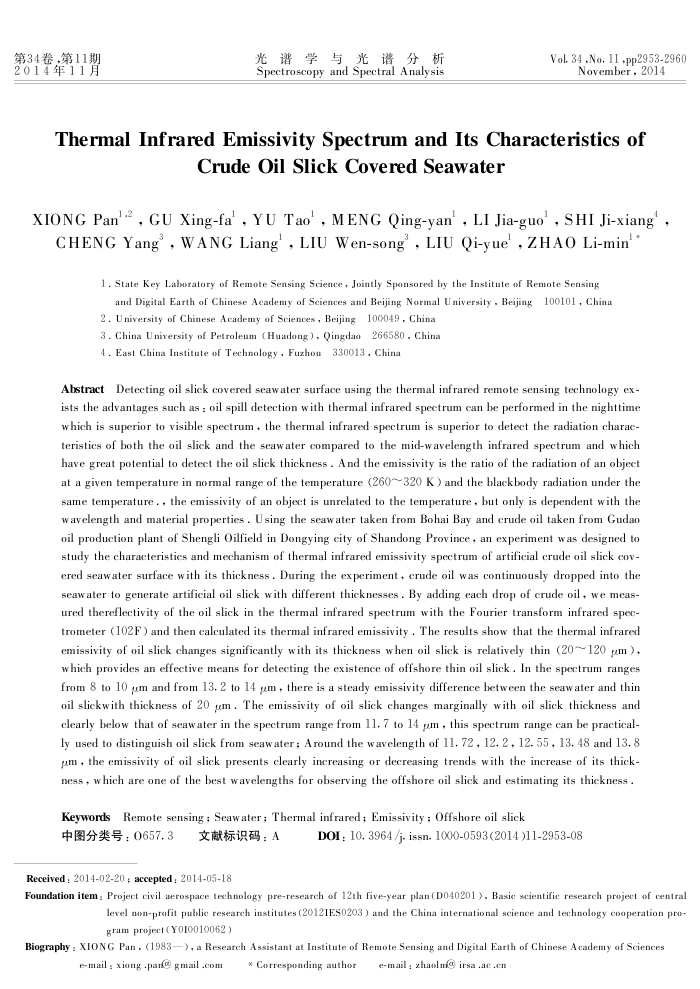您当前的位置:首页>论文资料>海面油膜热红外发射率光谱特征研究
内容简介
 第34卷,第11期 2014年11月
第34卷,第11期 2014年11月光谱学与光谱分析 Spectroscopy and Spectral Analysis
Vol. 34,No.11 -pp2953-2960
November,2014
Thermal Infrared Emissivity Spectrum and Its Characteristics of
CrudeOilSlickCoveredSeawater
XIONG Pan'.2,GU Xing-fa',YU Tao',MENG Qing-yan',LI Jia-guo',SHI Ji-xiang
CHENGYang,WANGLiang',LIUWen-song",LIU Qi-yue,ZHAOLi-min
1 . State Key Laboratory of Remote Sensing Science , Jointly Sponsored by the Institute of Remote Sensing and Digital Earth of Chinese Academy of Seiences and Beijing Normal U niversity , Beijing 100101 , China
2 . University of Chinese Academy of Sciences , Bejing 100049 , China 3. China University of Petroleum (Huadong), Qingdao 266580 , China 4. East China Institute of Technology , Fuzhou330013, China
Abstract Detecting oil slick covered seawater surface using the thermal infrared remote sensing technology ex-ists the advantages such as : oil spill detection with thermal infrared spectrum can be performed in the nighttime which is superior to visible spectrum , the thermal infrared spectrum is superior to detect the radiation charac-teristics of both the oil slick and the seawater compared to the mid-wavelength infrared spectrum and which have great potential to detect the oil slick thickness . And the emissivity is the ratio of the radiation of an object at a given temperature in normal range of the temperature (260~320 K) and the blackbody radiation under the same temperature . , the emissivity of an object is unrelated to the temperature , but only is dependent with the wavelength and material properties . U sing the seawater taken from Bohai Bay and crude oil taken from Gudao oil production plant of Shengli Oilfield in Dongying city of Shandong Province , an experiment was designed to study the characteristics and mechanism of thermal infrared emissivity spectrum of artificial crude oil slick cov-ered seawater surface with its thickness . During the experiment , crude oil was continuously dropped into the seawater to generate artificial oil slick with different thicknesses . By adding each drop of crude oil , we meas-ured thereflectivity of the oil slick in the thermal infrared spectrum with the Fourier transform infrared spec-trometer (102F ) and then calculated its thermal infrared emissivity . The results show that the thermal infrared emissivity of oil slick changes significantly with its thickness when oil slick is relatively thin (20~120 gm ), which provides an effective means for detecting the existence of offshore thin oil slick . In the spectrum ranges from 8 to 10 μm and from 13. 2 to 14 μm , there is a steady emissivity difference between the seawater and thin oil slickwith thickness of 20 μm . The emissivity of oil slick changes marginally with oil slick thickness and clearly below that of seawater in the spectrum range from ll, 7 to l4 gm , this spectrum range can be practical-ly used to distinguish oil slick from seawater ; Around the wavelength of 11. 72, 12. 2, 12. 55, 13. 48 and 13. 8 μm , the emissivity of oil slick presents clearly increasing or decreasing trends with the increase of its thick ness , w hich are one of the best wavelengths for observing the offshore oil slick and estimating its thickness .
Keywords Remote sensing ; Seawater ; Thermal infrared ; Emissivity ; Offshore oil slick
中图分类号:0657.3
文献标识码:A
Received : 2014-02-20 ; aceepted: 2014-05-18
DOI: 10. 3964/j. issn. 1000-0593(2014)11-2953-08
Foundation item: Project civil aerospace technology pre-research of 12th five-year plan (D040201 ), Basic scientific research project of central
level non-profit public research institutes (20121ES0203 ) and the China international science and technology cooperation pro gram project(Y010010062)
Biography : XIONG Pan , (1983—), a Research Assistant at Institute of Remote Sensing and Digital Earth of Chinese Academy of Sciences
e-mail : xiong -par@ gmail .com
Corresponding author
e-mail ; zhaolm irsa .ac.cn